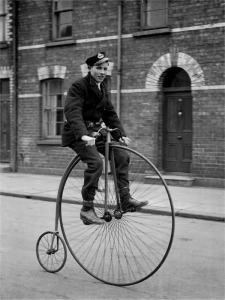The Big Wheel ~ The Penny-Farthing Bicycle
You’ve probably seen them in movies or, like me, in a museum. They seem quaint to us now, but in the 1880s and 1890s, they were all the rage, especially with men who had plenty of leisure time and the money to enjoy it. They were the bicycles with the enormous front wheel and the tiny back wheel, with the rider perched on a tiny seat precariously over the front wheel. They were commonly called “high wheel” or just “wheel,” but the name by which they are usually known today is “penny farthing,” for the size relationship between an English penny and a farthing when those two coins are placed side by side.
The large front wheel on the penny-farthing bicycle allowed for higher speeds on all but steep hills and made for a smooth and comfortable ride over ruts, stones, or any other obstructions on unpaved roads. The high elevation at which the rider sat was not for the faint of heart, but getting on and off the penny-farthing—and staying on—could be learned easily enough for those willing to try. One foot was placed on a peg above the back wheel. The rider grasped the handlebar, scooting and lifting himself onto the saddle. People who wanted to ride the penny-farthing usually began with a regular-sized “velocipede” bicycle to get the hang of it and learn the moves.
Riding a penny-farthing was not without risk, even for the skilled. Riders were subject to “headers,” being thrown over the handlebars when the front tire struck an obstruction in the road. These “headers” could be fatal, but the development of “moustache” handlebars (allowing the rider to keep his feet on the pedals and leap feet-first forward off the bicycle if such a move was necessary) made for a safer ride. Other safety innovations included moving the seat rearward and driving the wheels by levers or treadles or by a chain at the hub.
The penny-farthing bicycle is today a symbol of the late Victorian era. Its popularity coincided with the birth of cycling as a sport. While it became enormously popular in its day, it faded in popularity with the rise of the so-called “safety bicycle,” which boasted the innovations of a chain drive and a pneumatic bicycle tire.
People are still riding penny-farthing bicycles today, although they are admittedly rare and you might go a lifetime without ever seeing one. Clubs and societies exist throughout the world that keep the tradition alive.
Copyright © 2011 by Allen Kopp

